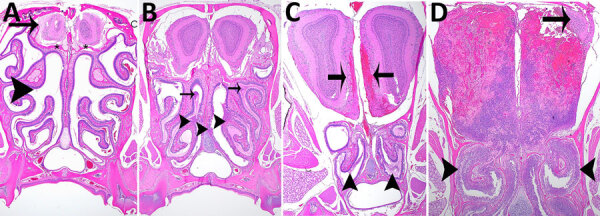Figure 8.

Hematoxylin and eosin staining of head sections of C57BL/6 mice exposed to aerosolized Burkholderia pseudomallei strain ATS2021, the causative strain in an outbreak of 4 cases, 2 of them fatal, in the United States in 2021. Shown are the nasal cavity (including nasal turbinates, nasal septum, respiratory and olfactory epithelium, lamina propria with supporting tissues and glands, nerve bundles, and nasal air passages); cribriform plate (bone and olfactory/trigeminal nerves); and cranial vault with olfactory bulb. A) Day 1 after exposure, dose 107 CFU, showing nasal turbinates (arrowhead), cribriform plate (asterisks), and olfactory bulb (arrow) that are essentially normal. Original magnification ×2. B) Day 2 after exposure, dose 4,490 CFU, showing mild necrosuppurative rhinitis (arrowheads) with edema, cellular debris and suppurative inflammation in few nasal air passages (arrows). Original magnification ×2. C) Day 3 after exposure, dose 4,490 CFU, showing multifocal moderate necrosuppurative rhinitis (arrowheads) and necrotizing and hemorrhagic meningoencephalitis of the olfactory bulb (arrows). Original magnification 2. D) Day 4 after exposure, dose 1,150 CFU. There is diffuse necrosuppurative rhinitis of the nasal turbinates (arrowheads), showing extensive necrosis and hemorrhage of the olfactory bulb with a small portion of recognizable neural tissue evident (arrow). Original magnification ×2.
